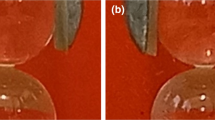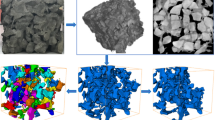Abstract
This paper deals with flow properties of mercury (Mercury Intrusion Porosimetry, MIP) and water (permeability measurements and capillarity) in building materials. The aim of this work is to study the validity range of the constancy hypothesis of the contact angle, usually admitted in porosity measurements (MIP, and capillarity), by establishing an explicit relationship between the contact angle and the capillary radius.
For mercury and water we have showed that: (i) on one hand, for a given value of pressure, the contact angle between the liquid and the capillary walls starts to change significantly only from a ‘critical’ value of capillary radiusR, (ii) on the other hand, in static state, the sphericity of liquid front depends equally on the capillary radius: the water has a spherical form whenR≤10 μm, mercury has this form only for pores with radiusR≤103 μm. This expresses the framework of Washburn's law applicability.
Résumé
Cette étude traite des propriétés d'écoulement du mercure (essai de porosimétrie) et de l'eau (essai de perméabilité, remontées capillaires) dans les matériaux poreux de génie civil. En explicitant l'expression de l'angle de contact en fonction du rayon du capillaire, le but en est d'étudier le domaine de validité de l'hypothèse de la constance de cet angle de contact, couramment admise en mesures expérimentales (porosimétrie au mercure et capillarité).
Nous y démontrons pour les deux liquides que: (i) d'une part, pour une valeur de pression donnée, l'angle de contact liquide—parois du capillaire ne commence à évoluer d'une façon significative qu'à partir d'une valeur R minimale de rayon de capillaire, (ii) d'autre part, en état statique, la sphéricité du front liquide dépend également du rayon du capillaire: l'eau conserve un front sphérique jusqu'aux rayons de l'ordre de 10 μm R≤10 μm), alors que le mercure ne le maintient que pour les rayons inférieurs ou égaux à 103 μm (R≤103 μm). Ceci traduit le domaine de validité de la loi de Washburn.
Similar content being viewed by others
References
De Gennes, P.G. et Guyon, E., ‘Lois générales pour l'injection d'un fluide dans un milieu poreux aléatoire’,Journal de Mécanique 17 (1978) 402–432.
Lenormand, R., ‘Déplacements polyphasiques en milieux poreux sous l'influence des forces capillaires’, Thèse de l'Institut National Polytechnique de Toulouse (1981).
Shikhmurzaev, Y.D., ‘Spreading flow of a viscous liquid over a solid surface’,Sov. Phys. Dock. 36 (1991) 749–752.
Shikhmurzaev, Y.D., ‘Dynamic contact angles and flow in vicinity of moving contact line’,AICHE Journal 42 (1996) 601–612.
Dulien, F.A., ‘Porous Media—Fluid Transport and Pore Structure’ (Academic Press, New-York, 1979).
Joanny, J.F., ‘Le mouillage, quelques problèmes statiques et dynamiques’, Thèse de l'Université Pierre et Marie Curie, Paris (1985).
Szekely, J., Neumann, A.W. and Chuang, Y.K., ‘The rate of capillary penetration and the applicability of the Washburn Equation’,Journal of Colloid and Interface Science 35 (1971) 273–278.
Martys, N.S., ‘Diffusion in partially-saturated porous materials’,Mater. Struct. 32 (1999) 555–562.
Xu, K., ‘Structures multi-échelles, modèles pour la description des matériaux poreux et l'estimation de leurs propriétés de transport’, Thèse de l'Université de Grenoble I (1995).
Cook, R.A. and Hover, K.C., ‘Mercury porosimetry of hardened cement paste’,Cem. Conc. Res. 29 (1999) 933–943.
Laskar, Md A.I., ‘Some aspects of evaluation of concrete through mercury intrusion porosimetry’,Cem. Conc. Res. 27 (1997) 93–105.
Aït-Mokhtar, A., Amiri, O. and Sammartino, S., ‘Analytic modelling and experimental study of the porosity and the permeability of a porous media—Application to cement mortars and granitic rock’,Magazine of Concrete Research 51 (1999) 391–396.
Hoffman, R., ‘A study of the advancing interface’,Journal of Colloid and Interface Science 50 (1975) 228–241.
Riecken, B., ‘Capillary suction in highly porous media—A parametric study’, PhD Thesis of the University of Aachen (Germany) (1996) (only available in German).
Brand, L., ‘Vector and tensor analysis’, 8th Edn. (John Wiley and Sons Inc., New-York, 1962).
Lemong-Ferrand, J. and Arnaudies, J.M., ‘Cours de Mathématiques, Tome 3, Géométrie et Cinématique’, 2e Edn. (Dunod, Paris, 1977).
Shikhmurzaev, Y.D., ‘Mathematical modelling of wetting hydrodynamic Fluids’,Dynamics Research 13 (1994) 45–64.
Aïtcin, P.C., ‘Bétons haute performance’ (Eyrolles, Paris, 2001).
Author information
Authors and Affiliations
Rights and permissions
About this article
Cite this article
Aït-Mokhtar, A., Amiri, O., Dumargue, P. et al. On the applicability of Washburn law: study of mercury and water flow properties in cement-based materials. Mat. Struct. 37, 107–113 (2004). https://doi.org/10.1007/BF02486606
Received:
Revised:
Accepted:
Issue Date:
DOI: https://doi.org/10.1007/BF02486606




